Sample Balance Sheet
Below is a completed sample balance sheet.
This was achieved using six transactions which are explained in six steps.
Each step shows how each transaction affects the balance sheet and includes a sample of the balance sheet as it is updated.
You can work through these steps to build your confidence and understanding for pulling together a basic balance sheet.
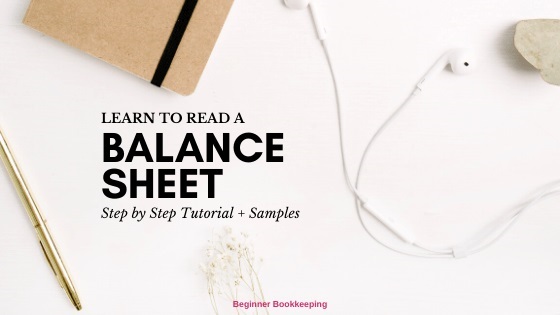
I recommend reading up on the accounting equation first because it plays an important role in producing balance sheets which are derived using the double-entry bookkeeping method.
You can read my article on the accounting balance sheet which explains the meaning of the accounts and sections of a balance sheet.
The layout of this balance sheet sample is explained near the bottom of this page.
If you require a different layout, the templates are down there for you to download.
You can still work through the same steps to see the affect.
The main difference between the different layouts is in how the final totals are calculated - the individual accounts themselves do not change.
Balance Sheet Template in Excel
You can download the free excel balance sheet template in excel to practice with
There are two other template layouts at the bottom of this page for you to download if you require the other layouts.
Sample Balance Sheet - Completed
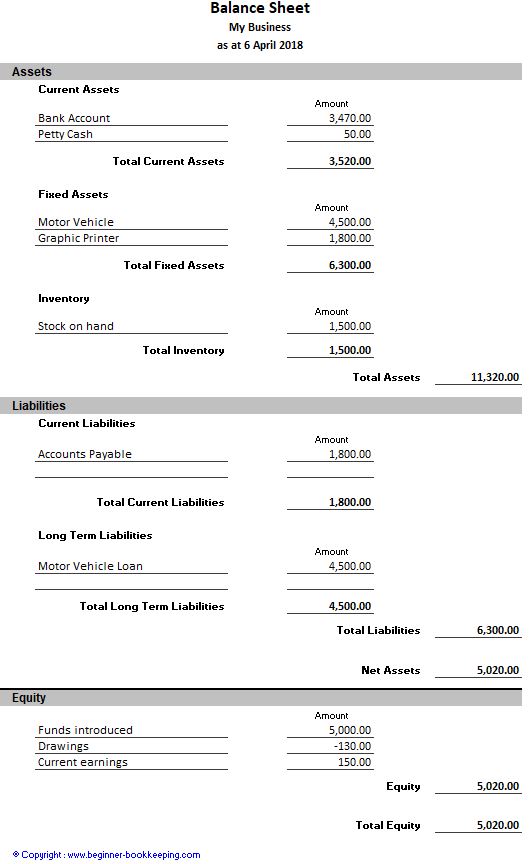 Sample Balance Sheet
Sample Balance SheetThere are three main sections:
Assets : are what your business owns or who owes money to your business.
Liabilities : are what your business owes to others - the debt you have to pay off.
Equity : is the value of your ownership of the business.
The net assets and total equity should always equal the same.
The business Model
(This is a completely fictitious
company made up of my own imagination and is not based on any living
person or real business.)
Shelly-Anne started up a graphic design business which she registered
as a company.
Each day, when she carried out a business transaction the balance sheet changed to reflect this transaction.
This has been greatly simplified with just one or two transactions per day so you can easily see the effect they make.
Each change is highlighted.
There are always two changes to maintain the double-entry method of bookkeeping.
You may want to read just one 'Day' per day to help you digest and
remember what you have read before moving on to the next 'Day'.
Day 1
Shelly-Anne introduced her own money of $5,000.00 into the business.
- $5,000 is deposited into the business bank account increasing it
from $0 to $5,000 (asset)
- $50 is withdrawn from the business bank account and deposited into
the petty cash box (asset)
Effect on balance sheet:
- $4,950 is the amount left in the bank account at the end of the day.
- $50 is the amount in the petty cash account at the end of the day.
- $5,000 is the amount in the Equity account at the end of the day.
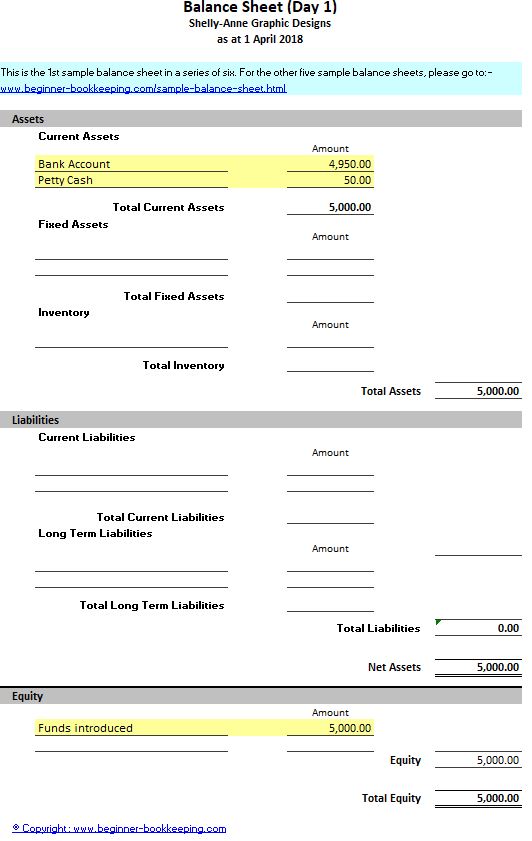 Day 1 Sample Balance Sheet
Day 1 Sample Balance SheetDay 2
The next day, Shelly-Anne brought t-shirts and caps to sell. She paid the cost in full by bank transfer.
- $2,000 was spent out of the bank account to pay for the shirts and
caps, thus reducing the bank balance (asset)
- $2,000 worth of stock (the shirts and caps) is placed into the stock
room (asset)
Effect on balance sheet :
- $2,950 is
the amount left in the bank account at the end of the day
- $2,000 is
the amount in the stock account at the end of the day
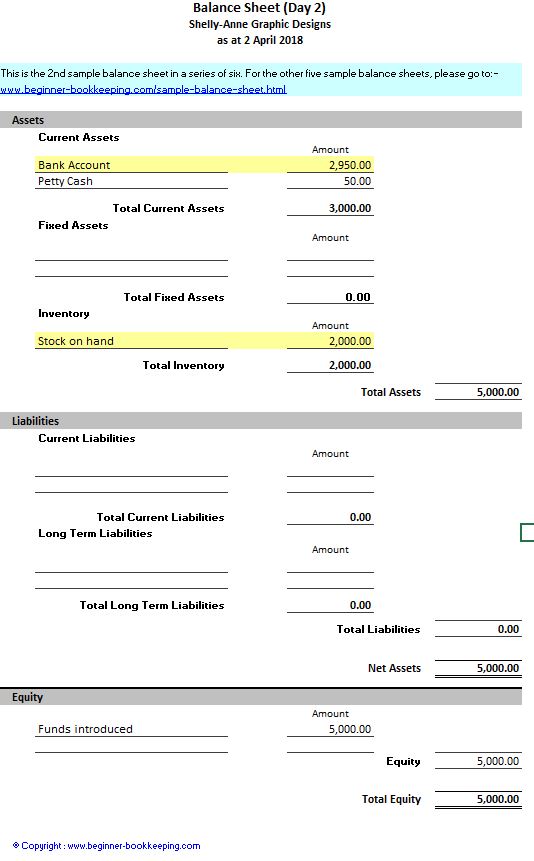 Day 2 Balance Sheet Sample
Day 2 Balance Sheet SampleDay 3
Part 1
The next day, Shelly-Anne sold some shirts and caps to her first customer who paid cash. Shelly-Anne deposited the cash that same day.
- $650 of income was deposited into the bank account, which
increased the bank balance
- $500 worth of stock is taken out of the stock room and handed
over to the customer
- $150 is the profit Shelly-Anne makes on the sale of her stock
because she added a 30% markup to the stock before selling
it.
Effect on balance sheet
- $3,600 is
the amount left in the bank account at the end of the day
- $1,500 is
the amount in the stock account at the end of the day
- $150 is added to the current earnings. This is the net profit and is calculated using a simple income statement.
You may have come across balance sheets with 'Retained Earnings' listed above 'Current Earnings'. Retained earnings are the accumulated net profits from previous years' trading. Current earnings will only ever show the net profit from the current financial year.
Part 2
Also on this third day Shelly-Anne used petty cash to buy some stationery
- $10 of cash was used, which decreased the amount of petty cash
- $10
worth of stationery was purchased and placed on Shelly-Anne's desk - this decreases the current earnings because
expenses decrease the net profit of a business
Effect on balance sheet :
- $40 is
the amount left in the petty cash account at the end of the day
- $140 is
the amount left in the current earnings account at the end of the
day
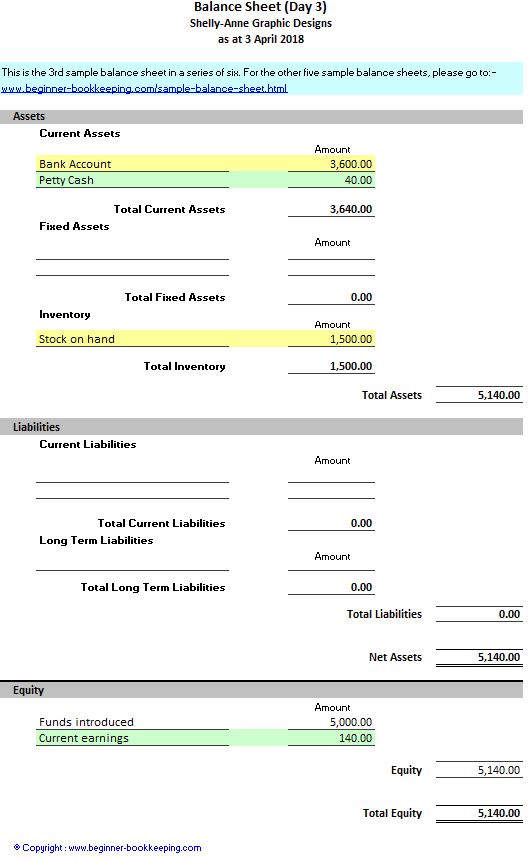 Day 3 Sample Balance Sheet
Day 3 Sample Balance SheetDay 4
On the fourth day, Shelly-Anne brought a van for her business. She was given approval of a finance loan to pay for it, which she was contracted to pay off over 3 years.
-
$4,500 is the value of the new van
-
$4,500 is the amount of the loan
(Note the interest on Shelly-Anne's future loan repayments is an expense to the business so will not be added to the loan account, but will decrease the current earnings - equity)
Effect on balance sheet
- $4,500 is
the amount added to the motor vehicle account
- $4,500 is
the amount added to the loan account - this is a long term liability
because it will take more that 12 months to pay off
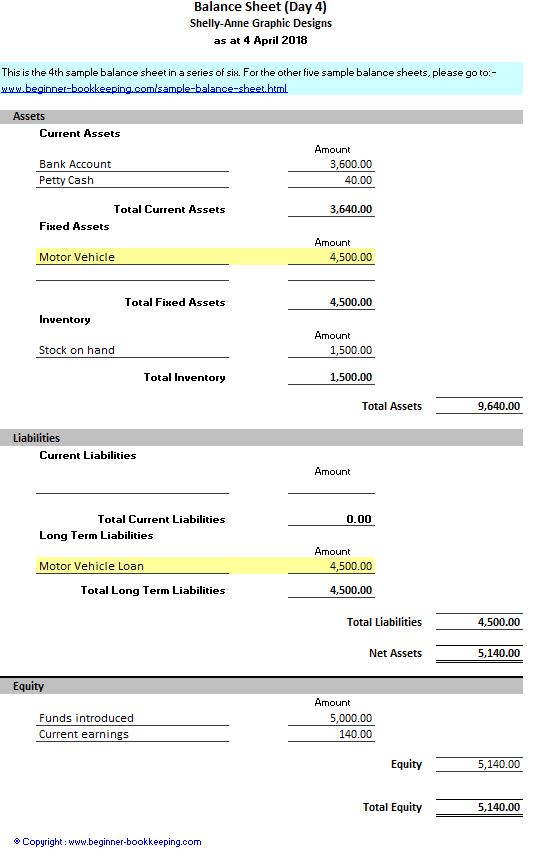 Day 4 Sample Balance Sheet
Day 4 Sample Balance SheetDay 5
On the fifth day, Shelly-Anne had run out of personal funds and needed to buy some groceries so she used $130 of the business funds.
- $130 is the amount spent out of the business bank account
- $130 is the amount used for personal expenses
Effect on balance sheet:
- $3,470 is
the amount left in the business bank account at the end of the day
- $130 is
placed against the drawings account on the balance sheet which
decreases the owner's equity.
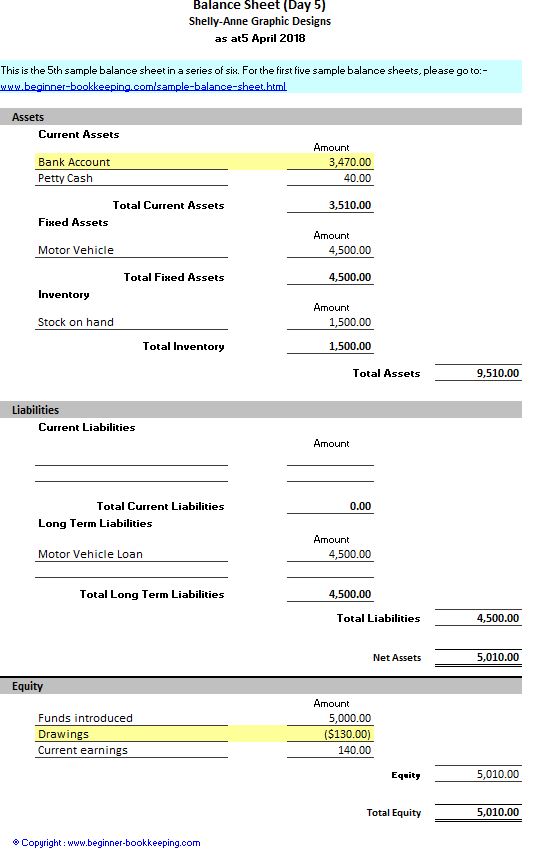 Day 5 Sample Balance Sheet
Day 5 Sample Balance SheetDay 6
On the sixth day (the final day for this business model), Shelly-Anne brought a specialized graphic printer.
She was able to open an account with the supplier, so she did not have to pay for it right away, but it did have to be paid for by the end of the following month.
-
$1,800 is the cost of the printer supplied by the vendor
- $1,800 is the amount Shelly-Anne's business owes to the vendor
(accounts payable)
Effect on balance sheet :
- $1,800 is
added to the graphic printer account which increases the overall
value of assets to $11,320
- $1,800 is
added to the creditors (accounts payable) account - this increases
the liabilities of the business to $6,300.
This is a current liability because it will be paid for within 12 months.
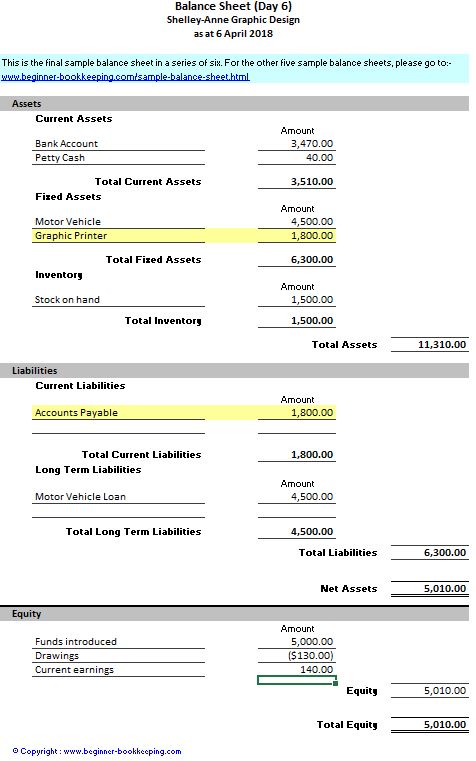 Sample Balance Sheet Day 6
Sample Balance Sheet Day 6Sample balance sheet Other Layouts
- In the sample balance sheet on this page I have shown the accounting equation to be:
assets - liabilities = equity
and is more common in places like the UK and New Zealand
the totals that must balance are Net Assets and Equity - However, it is also acceptable to work with the following equation:
assets = liabilities + equity
used in the USA/Canada
the totals that must balance are Assets and Liabilities/Equity
- You can see an example of this from QuickBooks as explained by fitssmallbusiness.com
- And this second equation is sometimes displayed side by side as in this example by the accountingcoach.com
With the above in mind, you can download the excel template for the two different layouts and see if you can work through each step to get the balance sheet in balance.
Below are examples of the Shelley-Anne's balance sheet using the different balance sheet layouts explained above.
Balance Sheet Sample Other Equation Layout
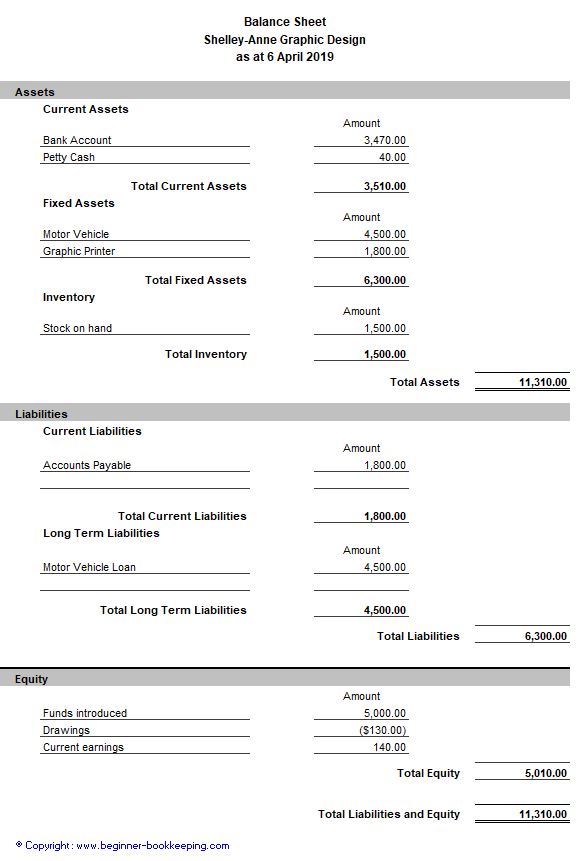
Balance Sheet Sample Side by Side Layout
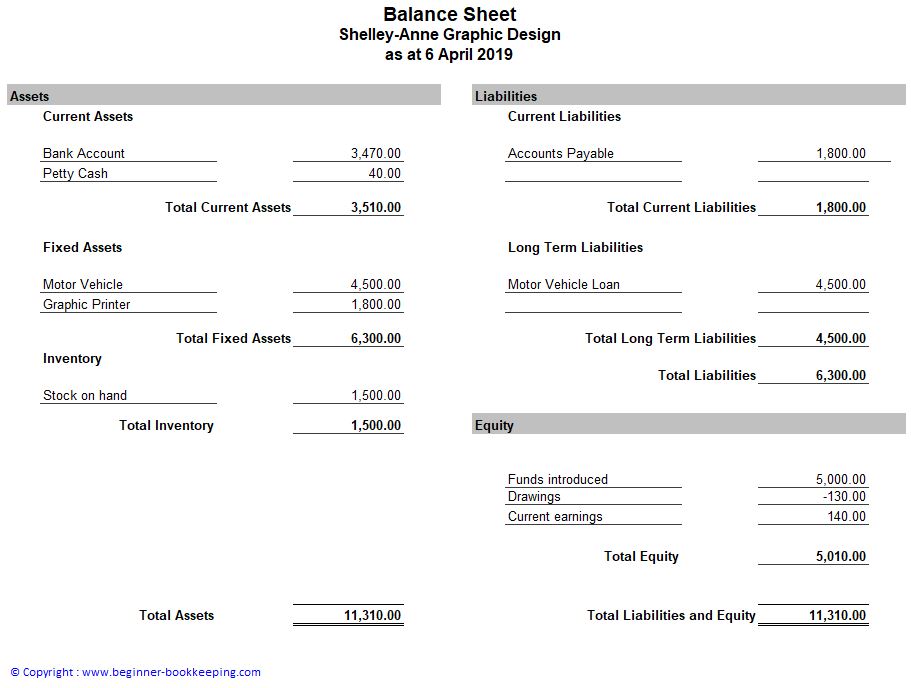
Home > Balance Sheet > Sample Balance Sheet
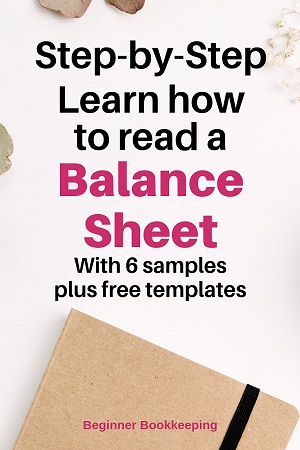





Facebook Comments
Leave me a comment in the box below.